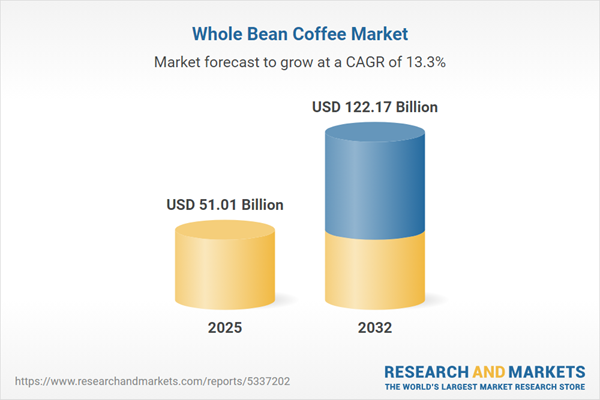Speak directly to the analyst to clarify any post sales queries you may have.
Senior executives face pivotal challenges as the global whole bean coffee market evolves under shifting consumer preferences, regulatory complexities, and the rise of digital commerce. Actionable intelligence is essential for maintaining competitiveness, adjusting to regulatory shifts, and building value in a rapidly transforming environment.
Market Snapshot: Whole Bean Coffee Market Growth Dynamics
The whole bean coffee market is experiencing sustained momentum, shaped by consumer emphasis on premium quality, demand for transparent sourcing practices, and growing expectations for seamless omnichannel availability. The sector achieved a global valuation of USD 44.95 billion in 2024, is projected to reach USD 51.01 billion by 2025, with a compound annual growth rate (CAGR) of 13.31%. The market is forecast to expand to USD 122.17 billion by 2032. Organizations are responding by investing in analytics, digital transformation, and innovation across the value chain. Both long-standing brands and new market entrants are accelerating strategies that leverage technology, adapt to regulatory mandates, and anticipate evolving consumer behaviors.
Scope & Segmentation: Actionable Insights for Strategic Leadership
- Bean Types: The report covers Arabica, robusta, and blended options, equipping leadership teams with data to align portfolios with specialty or mass-market goals.
- Roast Levels: Analysis of consumer preferences for light, medium, and dark roasts informs product development and guides alignment with varied taste trends.
- Distribution Channels: Examination of direct-to-consumer, third-party e-commerce, specialty retail, and supermarket strategies supports decision-making to maximize brand reach and adaptability.
- Packaging Types: Review of bulk, resealable stand-up pouch, flat pouch, and vacuum-sealed solutions helps stakeholders balance operational efficiency with freshness and environmental considerations.
- Price Tiers: Benchmarking across economy, standard, and premium categories empowers leaders to craft targeted value propositions for distinct market segments.
- Regional Coverage: Analysis spans North America, Europe, Middle East and Africa, and Asia-Pacific, with in-depth attention to the U.S., Brazil, U.K., UAE, South Africa, China, and India, enhancing regional decision-making and compliance strategies.
- Companies Analyzed: Profiles of major players such as Nestlé S.A., JDE Peet’s N.V., The J.M. Smucker Company, Starbucks Corporation, Lavazza Group S.p.A., Tchibo GmbH, Strauss Group Ltd., Illycaffè S.p.A., Ueshima Coffee Co., Ltd., and Massimo Zanetti Beverage Group S.p.A. provide assessments on sourcing, digital capabilities, and competitive brand strategies.
Key Takeaways for Executive Action
- Expanding direct-to-consumer and subscription models strengthens brand presence while enhancing responsiveness to changing demand patterns across regions and sales channels.
- Emphasizing transparent sourcing and rigorous compliance initiatives bolsters stakeholder trust and provides resilience in diverse regulatory environments.
- Product innovation, such as developing distinct roast profiles and broadening single-origin offerings, supports differentiated positioning and advances market leadership.
- Contemporary packaging solutions are strategically chosen to optimize sustainability credentials and shelf appeal across both online and traditional retail spaces.
- Addressing health and wellness preferences creates new long-term avenues for product innovation as consumer lifestyle priorities evolve.
- Targeted localization in marketing and distribution, with a focus on regulatory alignment and cultural sensitivity, enables scalable global growth and deeper consumer engagement.
Tariff Impact: Navigating 2025 U.S. Regulatory Changes
In response to recently updated U.S. coffee import tariffs, companies are reviewing sourcing frameworks, strengthening supplier networks, and investing in end-to-end supply chain transparency. Practical steps include recalibrating procurement strategies and renegotiating contracts, ensuring supply continuity and consistent product standards within emerging regulatory requirements.
Methodology & Data Sources
The report is grounded in primary interviews with market and supply chain experts, augmented by thorough secondary research of industry publications and corporate disclosures. This multi-source approach meets rigorous standards for validity, supplying executives with the robust intelligence needed for informed decisions.
Why This Report Matters for Senior Leaders in the Whole Bean Coffee Market
- Supports the refinement of product, price, and distribution strategies with reliable insights aligned to rapid market changes.
- Offers timely guidance on sustainable sourcing, digital sales expansion, and transparency measures essential for long-term market resilience.
- Prepares organizations to anticipate regulatory developments and adapt to ongoing competitive shifts within the coffee industry.
Conclusion
This analysis equips business leaders with the strategic clarity to address market challenges, capture emerging opportunities, and pursue sustainable growth in the evolving whole bean coffee sector.
Additional Product Information:
- Purchase of this report includes 1 year online access with quarterly updates.
- This report can be updated on request. Please contact our Customer Experience team using the Ask a Question widget on our website.
Table of Contents
3. Executive Summary
4. Market Overview
7. Cumulative Impact of Artificial Intelligence 2025
Companies Mentioned
The companies profiled in this Whole Bean Coffee market report include:- Nestlé S.A.
- JDE Peet’s N.V.
- The J.M. Smucker Company
- Starbucks Corporation
- Lavazza Group S.p.A.
- Tchibo GmbH
- Strauss Group Ltd.
- Illycaffè S.p.A.
- Ueshima Coffee Co., Ltd.
- Massimo Zanetti Beverage Group S.p.A.
Table Information
| Report Attribute | Details |
|---|---|
| No. of Pages | 195 |
| Published | October 2025 |
| Forecast Period | 2025 - 2032 |
| Estimated Market Value ( USD | $ 51.01 Billion |
| Forecasted Market Value ( USD | $ 122.17 Billion |
| Compound Annual Growth Rate | 13.3% |
| Regions Covered | Global |
| No. of Companies Mentioned | 11 |









